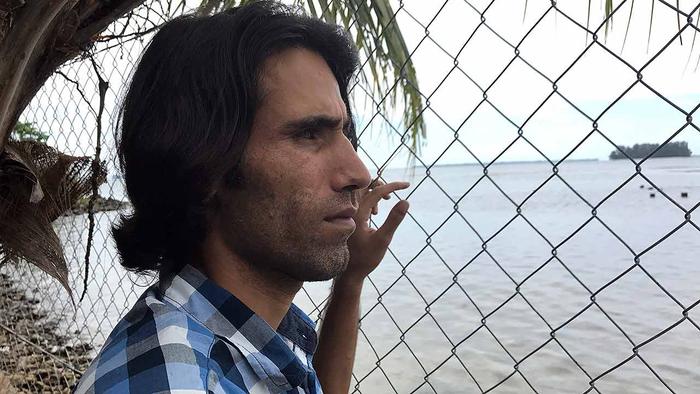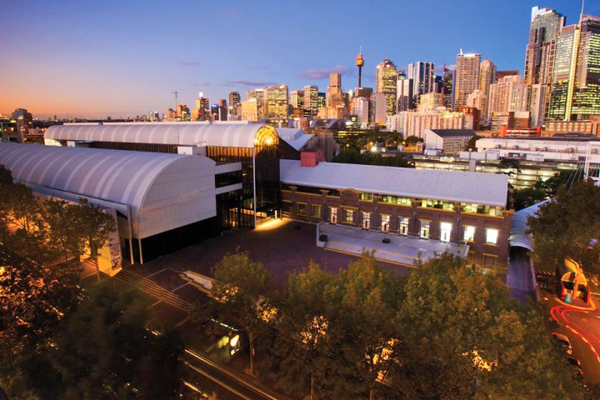By JUDITH WHITE
Soccer, refugees and the arts
Former Socceroos captain Craig Foster has written an impassioned open letter to Prime Minister Scott Morrison and Opposition Leader Bill Shorten pleading for humane treatment of refugees.
Waiting until refugee footballer Hakeem Al-Araibi is safely home in Australia (they are pictured together, above), he writes: “The fact that Parliament faced such a considerable challenge to pass legislation simply to provide medical care to refugees, fellow human beings, shows that we have gone too far, strayed from our basic values of humanity, that we need to step back and consider as a nation who we are and what we stand for. The policy of indefinite, offshore detention does not uphold our international obligations and we need to be strong enough to admit this and to find a fair and humane solution to this crisis of our conscience… We all saved Hakeem, together, and it will be up to all of our national leaders, irrespective of who ultimately prevails in the forthcoming election, to ensure that we now save ourselves.”
What does this have to do with the crisis in Australia’s cultural institutions? Everything!
The creative, outward-looking society I found when I arrived in this country as an immigrant in 1986 drew its strength from free education and institutions that encouraged independent thinking and artistic expression. The neoliberal agenda espoused by both major political parties, and rabidly promoted by the Murdoch media, has eroded those values in favour of a culture of greed and xenophobia. The “fair go” was replaced by a tawdry free-for-all, and a few prospered while the rest fell behind.
In 2014 a group of artists boycotted the Sydney Biennale because its long-term sponsor the Transfield foundation had an indirect connection, through its parent Transfield company, to a $1.2 billion contract for running the refugee camps on Manus and Nauru. The artists were lambasted by then Federal Communications Minister Malcolm Turnbull and Arts Minister George Brandis. Turnbull accused them of “vicious ingratitude” and Brandis asked the Australia Council to deny funding to artists who “unreasonably” rejected private funding.
There was, and is, a legitimate debate to be had about the relationship between corporate sponsorship and the arts. But in its political context, the Biennale episode became part of a race to the bottom in Australian politics to sideline humanitarian concern for refugees in the name of “stopping the boats” – which the current Prime Minister, Scott Morrison, was then busy doing as Immigration Minister, something he still boasts about.

Award-winning writer Behrouz Boochani, imprisoned on Manus Island
Not everyone has been intimidated. Members of the arts community have been in the forefront of standing up for asylum seekers. Think of the outstanding Refugee Art Project, of the recent award of Victoria’s main literary prize to Manus refugee Behrouz Boochani for his book No Friend but the Mountains, of Man Booker prize-winning author Richard Flanagan’s denunciation of the “hell for refugees” that successive governments have created.
There are many Australians who agree with Craig Foster that the time has come to “save ourselves”. That means reasserting our humanitarian obligations to asylum seekers, meeting the requirements of indigenous peoples laid out in the Uluru Statement from the Heart, and returning our cultural and educational institutions to the mission for which they were founded: to raise the cultural level of society, give free and open access to everyone, and promote the public good.
“Toxic planning” in Emerald City
Premier Gladys Berejiklian’s NSW Government stands accused by some of the State’s most experienced museum professionals and former board members of a culture of “toxic planning” and of repeatedly using “flawed factoids”, a practice in which Arts Minister Don Harwin is considered “the worst offender”.
The accusations came at the most recent hearing, on 11 February, of the Upper House Inquiry into Museums and Galleries. Established in June 2016 and chaired by Shooters and Fishers MLC Robert Borsak, it has focused on the plan, first announced under Premier turned banker Mike Baird, to move the Powerhouse Museum from Ultimo to Parramatta.

The award-winning Ultimo home of the Powerhouse Museum
The 11 February hearing, expected to be the last before the 23 March State election, came after January’s announcement by Arts Minister Harwin of new appointments to the museum’s Board of Trustees. New directors include Darren Steinberg, CEO of investment manager Dexus, Paddy Carney of accountancy giant PwC, and David Borger of the Western Sydney Business Chamber.
In evidence to the inquiry former President Nick Pappas said he considered the new trustees “highly unsuitable”, adding: “The role and purpose of a great museum is to inspire and to stimulate exploration and thinking, not to tick the boxes of the government of the day. People understand the fiduciary obligations when they take part in trust discussions.
“The Hon. SHAOQUETT MOSELMANE: Have they met their fiduciary obligations?
“Mr PAPPAS: I believe they have not.
“The Hon. SHAOQUETT MOSELMANE: They have not?
“Mr PAPPAS: They have not.
“The Hon. SHAOQUETT MOSELMANE: Can you elaborate a little on that? In what way?
“Mr PAPPAS: For the very reasons I have already stated they have become obsequious followers to the whim of Government, which is not why statutory trusts exist.
“The Hon. WALT SECORD: Do you believe they have just become cheerleaders for the property deal?
“Mr PAPPAS: Cheerleaders and fawning participants.
“The Hon. WALT SECORD: Beneficiaries, maybe.
“Mr PAPPAS: I will stop there.”
Some of the most colourful evidence came from Lionel Glendenning, the museum’s Architect of Record, who has referred to the Premier as “Gladys in Wonderland”.

Lionel Glendenning, Architect of Record
“A broad pattern,” he said, “emerges in almost every government document, consultant report and statement… There have been factually flawed factoids; unprofessional opinions; false statements; inaccurate figures; an ignorance of impacts, particularly flooding, collection risks, expensive implicit relocation costs and astronomic building costs with no alternatives; and a blind attachment to the slogan ‘Move the Powerhouse Museum’. In reality it is a semantic and physical impossibility… It goes back to that very thing that David Williamson wrote about in Emerald City. God help us, it has come to pass—the asset stripping; the belief that somehow the highest and best use is a giant apartment building.”
Brad Finley Baker, who was for 25 years Powerhouse manager of exhibition development and design, testified to the Inquiry about the damaging impact of the “efficiency dividend” spending cuts on the entire sector:

Premier Gladys Berejiklian and Arts Minister Don Harwin
“The most significant failure of the [NSW Government’s] report in my opinion is that it underestimates the significance of staff reductions and restructuring which have taken a great deal of corporate knowledge, technical skills and most importantly the personal connections of people around the museum industry both nationally and internationally. The issue is not simply one about failing infrastructure… the people are an organisation’s greatest asset and I believe that they have been, to a large degree, poorly served… Over the last few years where I worked at the Powerhouse, efficiency dividends were biting very hard into our ability to change over galleries and to build new exhibitions … Redundancy programs have been run over the last several years. We have lost incredibly highly skilled staff through the process.”
Jennifer Sanders, former deputy director of the Powerhouse, picked apart the “business case” which had been kept secret until the Upper House forced its partial disclosure last year. The document was developed in the context of the Government’s 2016 announcement of a $600 million “cultural infrastructure” fund. “This $600 million,” she said, “was dangled like a carrot on a stick before NSW cultural entities vying to maximise the dollars for their bailiwicks with little thought given to a coherent, value-for-money approach.”
The entire transcript of the hearing is worth reading for anyone who cares about these matters.
What the Inquiry has revealed is that the financial projections for the cultural infrastructure spend are now looking hopelessly over-optimistic. Lionel Glendenning and others have estimated the real cost of the Powerhouse move at between $1.2 and $1.5 billion; while leading museum consultant Kylie Winkworth estimates that the true cost of the grandiose Sydney Modern extension at the Art Gallery of NSW will cost more than double the advertised estimate of $344 million – not to mention the increase in running costs for which the secret business case has made no known provision.
Both projects threaten to become millstones around the neck of the next government, whoever wins the March State election. Labor has now said it will halt the Powerhouse move if it wins, and that is to be welcomed, but its published policy fails to address the crucial question of the “efficiency dividend” and the hidden burden of recurrent funding for institutions.
Supporters of galleries and museums will need to remain ever vigilant if we are to have a chance of saving our culture.
For more background, order your copy of ‘Culture Heist’ at a special online price, HERE.

NSW Labor leader Michael Daley announces his arts policy
Updated 4pm 22 Feb – an earlier version incorrectly listed the new directors of MAAS. Apologies for any confusion.




fantastic report on such a critical issue. great shame our main media is so inept
every “secret business case ”
… becomes a public basket case
A great report on on such an imperative issue…the ‘rights’ of the arts are equal to the ‘rights’ of nature discourses. Craig Foster is also a national “treasure” advocating ‘rights’ of refugees and humanity.
Australia is so far behind in so many ways and I really can’t see a change in my lifetime. This country is a sports nation and always will be, because boof-head blokes run it! I will remain vigilant in my pursuit for the arts but disheartened… I am.